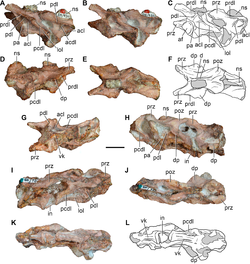Eorasaurus
|
Eorasaurus Temporal range: Late Permian, 255 Ma |
|
|---|---|
 |
|
| Vertebrae | |
| Scientific classification | |
| Kingdom: | Animalia |
| Phylum: | Chordata |
| Class: | Reptilia |
| Clade: | Archosauromorpha |
| Genus: |
†Eorasaurus Sennikov, 1997 |
| Type species | |
|
†Eorasaurus olsoni Sennikov, 1997 |
|
Eorasaurus is an extinct genus of archosauromorph known from the middle Late Permian (late Capitanian or early Wuchiapingian age) of Tatarstan, European Russia. It contains a single species, Eorasaurus olsoni. Eorasaurus was named by Andrey G. Sennikov in 1997. It is known from four specimens representing a single individual, PIN 156/108 through PIN 156/111, out of which PIN 156/109 was designed as the holotype. The material was collected from the Semin Ovrag locality, from the upper Severodvinian Horizon of the Volga River Basin. Sennikov (1997) assigned this genus to Protorosauridae, but Ezcurra et al. (2014) reclassified it as an archosauromorph.
PIN 156/108 through PIN 156/111 were discovered near the Volga River in Tatarstan, Russia in the 1930s and consist of nine cervical (neck) and dorsal (back) vertebrae as well as one dorsal rib and two limb bones. The body or centrum of each of the cervical vertebrae is irregularly shaped with many ridges (laminae) and pits (fossae). Ezcurra et al. (2014) note that Eorasaurus has additional bones called intercentra between its cervical vertebrae, conflicting with Sennikov's original reporting of a lack of intercentra. The neural arches of the specimens are fully fused with the centra, indicating that the individual was an adult when it died. A combination of features in the vertebrae of Eorasaurus distinguish it from other reptiles, including the presence of plates of bone on the vertebrae called prezygodiapophyseal and centrodiapophyseal laminae, the presence of cervical intercentra, and the overall irregular polygon-like shape of the vertebrae. An autapomorphy or unique characteristic of Eorasaurus is the presence of an additional lamina that splits off from the underside of the centrodiapophyseal lamina and crosses the centrodiapophyseal fossa.
...
Wikipedia
